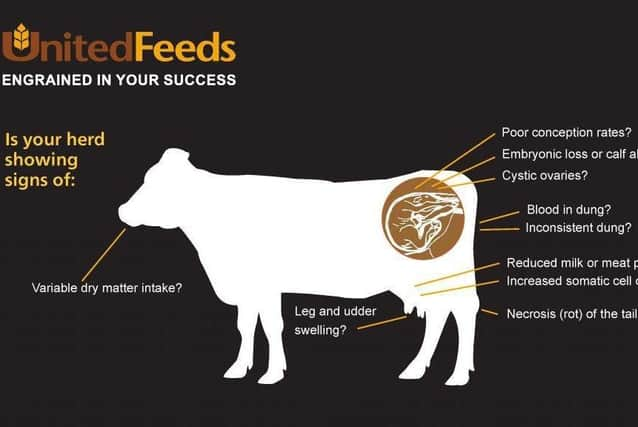Are Mycotoxins impacting performance on your herd?


What are mycotoxins?
Mycotoxins are natural substances produced by moulds and fungi. They are invisible, tasteless and toxic. More than 500 different mycotoxins have been identified to date, and most animal feedstuffs are likely to be contaminated to some degree. These include grazed grass, conserved forages (silage, wholecrop, maize, straw), homegrown and bought-in feed.
Each plant can be affected by more than one fungus, and each fungus can produce more than one mycotoxin. When multiple toxins are present, they can interact with each other, increasing the chances of synergistic effects. This is when the combined effects of two mycotoxins (even at low levels) are greater than the individual effects of each toxin.
Advertisement
Advertisement
Thoughts were that mycotoxins were a risk if forage was dry or had visible mould. Although this is true, mycotoxins can be present on any forage, of any dry matter, with no visible mould and excellent clamp face management.
What effects do mycotoxins have on animals?
They can affect any animal at any stage of production. Problems can be ongoing or flare up suddenly, even on the same pit of silage. This may be due to hitting pockets of mycotoxins in the clamp. Animals may exhibit one symptom or several.
Mycotoxins can reduce appetite, gut integrity and rumen function, decreasing the animal’s ability to absorb nutrients from feed, resulting in performance losses. Symptoms could be reduced milk yield, fluctuating milk yield, poor milk solids or reduced DLWG. Fluctuating forage intakes, variable dung consistency across a batch of animals or loose dung consistency can also be signs.
They suppress the immune system, which can manifest itself in multiple ways, including cell count problems, from raised SCC to increased cases of mastitis or E. coli, swollen hocks, lameness and rough coats.
Advertisement
Advertisement
Fertility problems can range from irregular heats, cysts, lower conception rates and abortions.
Some can even cause liver damage, kidney damage, internal haemorrhaging and muscle tremors.
What causes mycotoxins?
Field fungi (such as Fusarium sp.) typically occur pre-harvest, and storage fungi (such as Aspergillus and Penicillium sp.) typically occur post-harvest.
Contamination pre-harvest is caused by stress on growing crops. Harsh growing conditions and unfavourable harvesting conditions are becoming more common worldwide due to changeable weather. Contamination from slurry or farmyard manure on the leaf at the time of ensiling will impact the fermentation process due to the presence of clostridia bacteria. Likewise, soil contamination, of which we are seeing an increasing trend every year, also impacts the fermentation process.
How can we manage mycotoxins?
Advertisement
Advertisement
Try to limit slurry and soil contamination. Injection and trailing shoe applications will also help, and you should consider tedder/rake ground clearance. Consolidating the clamp well throughout ensiling is also advised.
Post-harvest mycotoxins can be caused by poor consolidation and clamp management but are easier to manage. Remove any visible mould from the clamp and do not feed to any animals. If mould is mixed in the TMR, it could cause mycotoxins to multiply. Problem areas tend to be down the sides and along the top of the clamp, but mycotoxins are certainly not confined to these areas alone.
Limiting the amount of time forage is exposed to oxygen reduces the chance of mycotoxin development. Only remove covers at the point of feeding, aim to move across the face as quickly as possible and, if needed, take half blocks. Use a sharp shear grab/block cutter to keep the face as clean and even as possible.
Talk to your United Feeds adviser who can recommend suitable ways to mitigate risks and if you believe you have an issue then feed Mycosorb A+® at an appropriate level for 10 days. Monitor production, forage intakes and dung consistency closely. If animals respond, continue feeding Mycosorb A+ until the forage source changes.
MYCOSORB A+®
Advertisement
Advertisement
Mycosorb A+ is a binder based on a specific strain of yeast. It is a broad-spectrum binder that tackles mycotoxins rather than dealing with individual mycotoxins. As it is a yeast-based binder, it will bind more efficiently to a greater range of mycotoxins reducing mycotoxin absorption without affecting vitamins and minerals. Vitamins and minerals are an expensive part of any diet, and by incorporating Mycosorb A+, you are ensuring the supply of these to your animals while managing the significant threat of mycotoxins.
When considering adding a mycotoxin binder to your feed, keep in mind that Mycosorb A+ offers the following:
- Proven by independent research
- A low effective inclusion rate
- Stable over a wide pH – this is necessary so that the mycotoxin stays attached to the binder throughout the gut and is then excreted
- Ability to absorb a high capacity and broad spectrum of mycotoxins
- Ability to react rapidly within the animal
Advertisement
Advertisement
Mycotoxins are a potential threat to productivity on every farm enterprise, so should be on every feed adviser and farmer’s radar. Speak to your local United Feeds nutritional adviser. Contact details can be found at www.ufeeds.com or by calling 028 9075 9000.